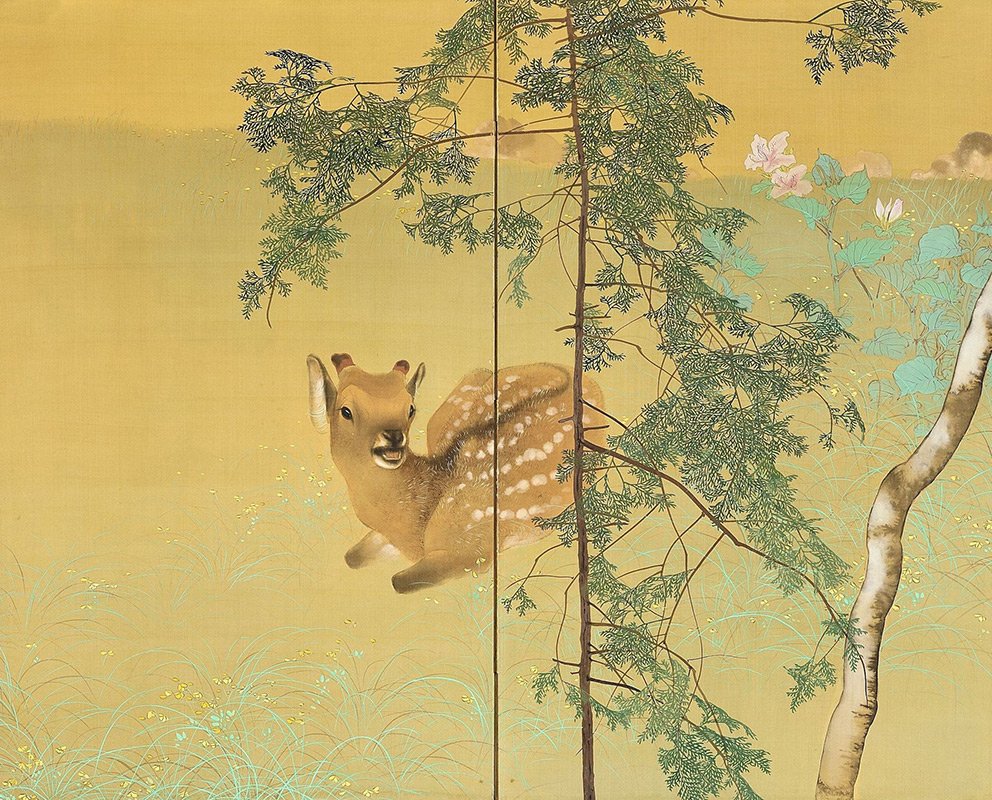PAINTINGS & SCREENS
KONOSHIMA OKOKU, 1911 BUNTEN EXHIBITION BYOBU OF DEER ON MOUNT WAKABA
Pair of byobu or folding screens in six panels, painted on silk in mineral pigments, gofun or clam shell gesso, and sumi ink, with a scene of a herd of deer resting on the slopes of Mount Wakaba on a sunny afternoon. Signed on the lower left side of the left-hand screen by the artist: Okoku, and sealed: Okoku (Konoshima Okoku, the go or art name of Konoshima Bunjiro, 1877 – 1938). With polished black eggshell lacquer frames. Meiji 44 or 1911.
Titled: Wakaba no Yama or Mount Wakaba, these paintings were made for exhibition at the 5th Bunten in 1911, where they won the 2nd prize. They are illustrated in the Nittenshi, volume 2, page 241, number 40. They were also exhibited in a retrospective of Okoku’s work held at the Kyoto Municipal Museum of Art in 1987 on the 50th anniversary of his death. The paintings are also illustrated in the catalogue of the exhibition, Botsu Go-jü Nen Konoshima Okoku Ten, number 4.
Born in Kyoto, Konoshima Okoku studied painting with Imao Keinen. In 1897 he was accepted into the first Zenkoku Kaiga Kyoshinkai or National Competitive Painting Exhibition, and continued to show his work in important exhibition venues every year until 1933. His work frequently won prizes at the Bunten. He served as a juror for both the Bunten and Teiten. From 1912 Okoku taught painting at the Kyoto Municipal Arts and Crafts School. Beginning in 1915, he taught at the Municipal Painting Vocational School until his retirement in 1925. After 1934 he retreated from public life to focus on the private practice of calligraphy and poetry writing.
His work is in the collections of the Idemitsu Museum of Art, the Kyoto City Art Museum, and the Tokyo National Museum of Modern Art. In 1987, a retrospective exhibition of his paintings was held at the Kyoto Municipal Museum.
For Paul Berry’s sensitive summary of this artist’s career, c.f. Modern Masters of Kyoto, The Transformation of Japanese Painting Traditions: Nihonga from the Griffith and Patricia Way Collection, pages 206 – 207.
Mount Wakaba lies in the Higashiyama area of Eastern Kyoto, where Okoku sets this late spring scene. The sloping edges of two hills rise up and melt into a background of bright sunshine. Gold applied behind the silk in urahaku technique imbues the light with a radiant glow. Finely detailed foliage and flowering Japanese azalea crisply contrast with the abstract background of the hillsides, the soft treatment of the lichen covered tree trunks, and the dozing deer. The deer Okoku paints with a sweet gentleness. Very few lines delineate the animals, making their fur and velvety horns appear yet softer against the surrounding leaves. We feel an intimate relationship with these wild, yet entirely tranquil creatures. The effect of Konoshima Okoku’s gentle naturalism seems as brilliant today as when these screens were first unfolded in 1911.
Konoshima Okoku, 1911 Bunten Exhibition Byobu of Deer on Mount Wakaba
Artist Name: Konoshima Okoku
Period: Meiji Taisho
Mediums: Mineral Pigments
Form: Screen
Origin Country: Japan
67 1/8” high x 146 ½” across, dimensions of each screen when opened flat
This piece is no longer available.


